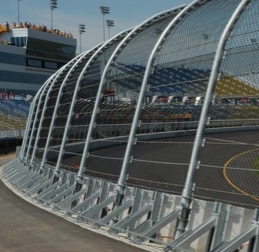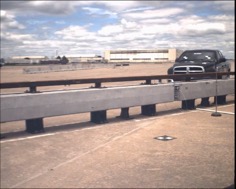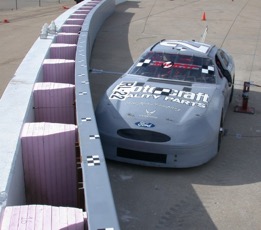Calendar Icon
May 31, 2018
Person Bust Icon
By College of Engineering
![]() RSS
Submit a Story
RSS
Submit a Story
The Midwest Roadside Safety Facility (MwRSF) at the University of Nebraska-Lincoln has been leading research that saves lives on America’s highways.
But for the last 20 years, Nebraska engineers and researchers have been more widely known for developing energy-absorbing walls that have kept drivers safe at major auto racing tracks.
NASCAR Drivers Visiting June 5
On June 5, NASCAR Xfinity Series driver Michael Annett and Camping World Truck Series driver Dalton Sargeant will come to campus to learn more about the SAFER (Steel and Foam Energy Reduction) barriers that protect them at NASCAR tracks, like Iowa Speedway in Newton, Iowa, where Annett and Sargent will race June 16-17. It is the only major track in the U.S. that uses SAFER walls throughout the facility.
Their visit will include an overview of the SAFER barrier research and development, which began at MwRSF in 1998; a tour of the Speedway Motors Museum of American Speed; and watching a full-scale crash test at the MwRSF Outdoor Proving Grounds on the western edge of Lincoln Municipal Airport.

SAFER Barrier Research
“Drivers have been for a long time the greatest advocates of safety in motor sports, and it’s good that they will be given a chance to understand what this technology can do and does for them,” said Ron Faller, director of the Midwest Roadside Safety Facility and a research professor in civil engineering. “From the beginning, it was IndyCar and NASCAR that have been our partners in making the tracks safer and the drivers have been engaged, too.”
The road to developing the SAFER barrier began in 1998, when open-wheel racing mogul Tony George and his Indy Racing League – now known as IndyCar – were struggling to come up with a “soft” wall that could protect drivers in high-speed crashes.
The PEDS (Polyethylene Energy Dissipating System) that had been installed at Indianapolis Motor Speedway was not working as seamlessly as they had hoped. Most notably, the crash of Arie Luyendyk during an IROC all-star race in 1998, caused his car to rebound off an infield wall and back into oncoming traffic as the wall disintegrated and a swath of debris was strewn across the track.
Shortly after that, George turned to MwRSF for help. It led to the development of the SAFER barrier.
“Tony has been an innovator in motorsports safety and that’s why he started this effort,” said Ron Faller, director of the Midwest Roadside Safety Facility. “He knew it needed to be done. It’s why he had his own people start the effort before he even came to us. They got to a point where they realized they didn’t know enough, and that’s when they reached out. It was a big step.”
For nearly four years, Nebraska engineers and researchers teamed up with motor sports experts to design multiple iterations of the wall and to conduct a large number of high-speed crash tests – MwRSF research engineering Bob Bielenberg says it was close to 25 tests – before the SAFER system was ready to go.
The SAFER system is designed with stacked square steel tubes that are welded together to form a 3-foot-high barrier. Between the tubes and the original concrete wall are bundles of closed-cell polystyrene foam that are designed to absorb and redistribute the kinetic energy created when a vehicle contacts the wall.

NASCAR, which owns and operates most of the major racetracks in the U.S., was also taking notice of the research and keeping tabs on what was going on at MwRSF. After watching a high-speed crash test at the proving grounds on the western edge of the Lincoln Municipal Airport, Bill France Jr. was sold on the technology, too, and the CEO of NASCAR invested in the project.
“They (IRL) were very focused on soft walls, soft materials – plastics, foams, things like that. We had to shift their thinking by showing them that the system itself doesn’t have to be soft but can have hard elements that can absorb and distribute energy,” Bielenberg said.
Before the SAFER barriers were first installed at Indianapolis Motor Speedway (IMS) in the spring of 2002, the American auto racing community was reeling from the deaths of five drivers in a short span of time, including NASCAR legend Dale Earnhardt at the Daytona 500 in February 2001.
Just days before installation, an IRL driver was severely injured in a crash during practice at IMS. Shortly after installation of the wall, another driver had an eerily similar crash during a practice and suffered only minor injuries.
Faller said that was the defining moment for SAFER barriers.
“It was one of two factors, the other being the data we had been collecting from other tracks with concrete walls that we could compare to our test data,” Faller said. “The comparisons were overwhelming. After seeing that second crash, people started to move forward.”
Since then, the SAFER system has been tweaked to make it safe for tracks that run both IndyCar (lighter, open-wheeled cars) and NASCAR (heavier stock cars) that use cars with very different body types.
Though the SAFER barrier has been in the spotlight for many years, it is far from the only thing the MwRSF has created or is known for.
“It is about this much of our research the last 20 years,” said Bielenberg, holding his right thumb and forefinger about an inch apart. “It’s very important, but it’s not been our main focus, which is and has always been highway safety. The SAFER barrier is a big branch that grew out of that.”
Other MwRSF Innovations
Technology created in the SAFER development has been used to inform other research and the development of many other barriers and devices, as MwRSF-developed roadside safety systems have been implemented in all 50 states.
Among the MwRSF innovations are:
*The Midwest Guardrail System, a 31-inch guardrail system that is considered the standard barrier used along American highways. It is named for the Midwest Pool Fund Program, of which Nebraska’s is one of 19 state departments of transportation that are members, that funded the research.
*The RESTORE barrier, a hybrid steel and concrete rail that is designed to contain and redirect high-energy truck impacts and lower impacts felt by passengers in the vehicle. It was part of the doctoral research done by Jennifer Schmidt, now a research assistant professor at MwRSF.
Faller said the MwRSF’s work on transportation safety, including the SAFER barriers, is not complete.
“Not even close. We can go beyond SAFER. We have not addressed local racetracks, which are the roots of auto racing – tracks like Eagle Speedway and I-80 Speedway (near Greenwood) and Beatrice Speedway,” Faller said. “Fan bases develop at those tracks and they are the places the next stars are born.”
But right now, Faller said, few of those tracks have the money to afford safety systems such as SAFER.
“There’s a desire in the racing community for us to develop almost a ‘SAFER Light.’ They need lower-cost safety improvements for all the mom-and-pop speedways across America,” Faller said. “That’s something that’s been asked of us, and we need to find the funding to go down that path.”
And there are innovations Faller is interested in pursuing as they relate to highway safety, including creating systems that have little-to-no physical presence.
“The future is in how we get into smart or connected infrastructure to the point where our roadside barriers are almost virtual,” Faller said. “They’re connected barriers and communicate with the car and driver before they become errant.”
Much like current technology that senses potential crash situations and instructs some newer cars to automatically brake, this barrier technology, Faller said, could prevent high-speed impacts that occur when vehicles exit a road at a high rate of speed and potentially save thousands of lives.
“There are tens of thousands of people who die in automobile crashes every year, and hundreds of thousands who are injured,” Faller said. The National Safety Council estimates that 40,100 people died in the U.S. in 2017 as a result of vehicular accidents. “Maybe we can develop a system that can keep those cars on the road and save lives. My dream, and our duty, is to make that happen.”
Submit a Story
